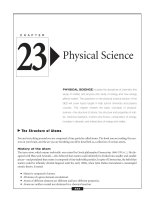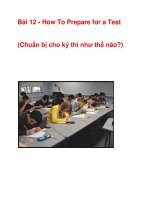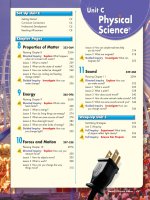3 12 how bikes work (physical science)
Bạn đang xem bản rút gọn của tài liệu. Xem và tải ngay bản đầy đủ của tài liệu tại đây (3.77 MB, 14 trang )
Genre
Nonfiction
Comprehension Skill
Summarize
Text Features
•
•
•
•
Captions
Labels
Text Boxes
Glossary
Science Content
Forces and Motion
Scott Foresman Science 3.12
ISBN 0-328-13843-6
ì<(sk$m)=bdiedc< +^-Ä-U-Ä-U
Vocabulary
Extended Vocabulary
friction
force
gravity
magnetism
motion
position
relative position
speed
work
absorb
center of gravity
contracts
reflectors
slope
terrain
traction
Picture Credits
Every effort has been made to secure permission and provide appropriate credit for photographic material.
The publisher deeply regrets any omission and pledges to correct errors called to its attention in subsequent editions.
Photo locators denoted as follows: Top (T), Center (C), Bottom (B), Left (L), Right (R), Background (Bkgd).
5 Tom Stewart/Corbis.
Unless otherwise acknowledged, all photographs are the copyright © of Dorling Kindersley, a division of Pearson.
ISBN: 0-328-13843-6
Copyright © Pearson Education, Inc. All Rights Reserved. Printed in the United States of America.
This publication is protected by Copyright, and permission should be obtained from the publisher prior to any
prohibited reproduction, storage in a retrieval system, or transmission in any form by any means, electronic,
mechanical, photocopying, recording, or likewise. For information regarding permission(s), write to
Permissions Department, Scott Foresman, 1900 East Lake Avenue, Glenview, Illinois 60025.
3 4 5 6 7 8 9 10 V010 13 12 11 10 09 08 07 06 05
What did you learn?
1. What are the three main types of
bicycles talked about in this book?
2. Why do cyclists switch to a lower
gear when riding uphill?
3. How do racing cyclists reduce
friction? Why?
by Judy Healy
4.
In this book you
have read about suspensions. Write to
explain why suspensions are helpful.
Include details from the book.
5.
Summarize Summarize the
importance of brakes and how
they work.
What You Already Know
Science studies movement. An object changes
position when it moves. Scientists compare objects
in motion to other objects. The relative position of
an object is where it is compared to other objects.
Speed is how fast an object changes position.
Speed depends on force. Force is a push or pull
that moves an object. Most forces are contact
forces. Friction is a contact force that works against
the motion of an object. Friction also affects the
speed of a moving object.
Speed also depends on the weight of the object.
An empty wagon rolls easily down a road. The
more objects that fill the wagon, the heavier it
becomes. This makes it harder to pull and slows
its speed.
Gravity is a non-contact force. All objects on
Earth are pulled toward Earth’s center by the force
of gravity. Magnetism is another non-contact force.
It is a strong force that pulls at certain kinds of
metals, such as those containing iron.
2
In science, the word work has a special meaning.
Work is done when force moves an object. People
have invented simple machines to do the same
amount of work with less force.
Riding a bicycle is work. In this book you will
learn about the bicycle and what happens to make
the work of riding possible. The bicycle uses force
from the rider to change the rider’s position. Let’s
learn how!
3
Marvelous Machines
Bicycles are marvelous machines. They help us
move faster and more easily than we can on foot.
Look at the bicycles in the picture. What do you
see? Can you name all the different parts of a
bicycle? Do you see handlebars? What about
wheels? Where are the pedals, gears, and axles?
In the next few pages you will learn about these
parts and how they make it possible for you to
ride a bike.
Scientists who study how objects move
are called physicists. These scientists study
the force, friction, work, and motion of
objects large and small. Physicists help
us understand how bicycles work.
Engineers are scientists who design
and build machines. Bicycle engineers
study physics to try to improve
bicycle designs. Now we will study the
physics and uses of bicycles!
4
Bikes are a lot of fun to ride.
They are useful machines.
5
Motion Magnifier
Like a Ferris wheel or merry-go-round,
a bicycle uses a wheel and axle. Our leg
muscles push on pedals that are attached
to a chain. The chain is attached to the
back wheel of the bike. The chain spins
the back axle. The axle is a bar that
connects the wheel to the bike.
The axle spins in a small circle. It moves the
back wheel in a large circle. The small spinning
of the axle is magnified in the large spinning of
the wheel. So the back axle and wheel receive
all the force of our leg muscles. The front wheel
is used for balance and steering. The back wheel
does all the work.
handlebar
seat
brake lever
There are many different parts of a
bicycle. Do you know them all?
water bottle
brake cable
brake block
tire
spoke
gear wheels
axle
pedal
chain wheel
gear-changing mechanism
6
chain
7
Geared Up
How Gears Work
Gears are an important part of a bicycle.
Different gears work best using different amounts
of force. Gears allow you to pedal the right
amount for the terrain you are riding on.
The gears are the smaller wheels near the axle.
They are called the gear wheels. This is where the
chain is attached. The chain also fits on two or
three larger different-sized wheels near the pedals.
These are called the chain wheels.
When cyclists bike uphill,
they often switch to a
lower gear.
8
This drawing shows two different chain wheels
from the same bike. In lowest gear, the smallest
chain wheel is connected to the largest gear wheel.
In highest gear, the largest chain wheel is connected
to the smallest gear wheel.
low gear
gear
wheel
high gear
chain
wheel
gear
wheel
chain wheel
A bicycle with many gears has different-sized
chain wheels and gear wheels. In high gear, you
need more force to turn the large chain wheel.
But this spins the back wheel faster. In low gear,
you need less force to turn the small chain
wheel. But this spins the back wheel more slowly.
It is much easier to spin the smaller chain
wheel. Lots of cyclists switch to low gear when
going uphill. The largest gear wheel moves slowly,
moving the rear wheel and the bicycle slowly.
This makes uphill cycling slower but easier.
9
Keeping
Balance
Can you ride a bike without
training wheels? How did you
learn? Did you fall a lot when
you learned? It takes practice
to learn to ride a bike
without training wheels.
To ride a bike, you
have to learn how to
balance. To balance on a
bike, most of your body must
be above the point where the tires
meet the ground. If you lean too
far one way, gravity will pull you
to the ground on that side. Bicycle
engineers must make sure the seat is
put in the right place. Otherwise,
it would be hard to balance.
Some people race their bicycles around
oval tracks. In this type of race, cyclists rely
on gravity and other forces for balance as
they ride around the curves. Gravity pulls
the cyclists in toward the curve. But their
pedaling pulls them outward. Racing cyclists
need to balance these two forces.
Some cyclists race on long courses, often
over hills or even mountains. These riders
must learn to ride across the slopes of hills.
Picture a hill near your home. Now think
about riding across the hill. Which way will
gravity be pulling you? Downhill. To ride
across slopes, cyclists lean into the hill. This
keeps their center of gravity on top of the
wheels so that the bike will stay upright
against the pull of gravity.
Balancing on a bike
takes practice.
10
11
Get a Grip!
There are many different forces working
against each other when a bike is moving.
Terrain, wheel traction, and wind all create
friction. Smooth tires grip smooth roads well.
Rough tires grip rough roads well. But smooth
tires slip on rough terrain since they do not have
enough friction. Rough tires create
too much friction on smooth
terrain, so cycling is slow
and difficult.
Rough tires help
grip this rough
terrain.
Friction helps all
cyclists on all types of
terrain keep their feet
on the pedals. Cleats
on the bottom of their
shoes, or straps on the
pedals, hold cyclists’
shoes in place. This
creates enough friction
for riders to keep their
feet on the pedals.
When riding
downhill, cyclists can
pick up so much speed
that they need to use
brakes to slow down.
Brakes create friction
that slows down a
moving bike. Most
brake controls are
on the handlebars.
Some bicycles have
back-pedal brakes.
road tire
off-road tire
How Brakes Work
Hand brakes rest on
both sides of the
wheel. When you
pull the controls, the
brakes pinch the
wheel. This makes
friction that slows
down the bike wheel.
caliper brakes
12
13
Reducing Friction
Racing cyclists try to cut down on friction so
they are able to ride faster. Racing cyclists lean
very low on their bikes. This lowers the amount
of friction from wind that hits the cyclists’ bodies.
Even racing cyclists’ clothes and helmets are made
to reduce friction from wind.
Racing cyclists lean forward
to reduce friction from wind.
Some types of friction can
be dangerous. When chain
wheels, gear wheels, and axles
spin, they rub against metal
parts. Where these metal
pieces rub one another,
friction results. This friction
causes the metals to wear
away. This kind of damage
is dangerous when it causes
the parts to break or
stop working.
Putting oil on metal
reduces friction and
makes spinning easier.
How Bearings Work
Bearings are smooth,
metal balls that roll easily.
They are used in places to
reduce friction where two
metals rub against each
other. Instead of the two
metals rubbing, the
bearings roll against the
metal. There is less friction
with rolling bearings.
14
bearings inside a bike
15
Riding the Bumps
Bicycle wheels were once made of wood or
metal. Think about riding on a bumpy road with
wooden or metal wheels! They would not flex or
bend, so you would feel every pebble. Modern
bicycles are designed to make riding smooth and
comfortable. Tires are made of rubber and filled
with air. This helps absorb some
of the bumps. When the tire
hits a pebble, the soft,
air-filled tube absorbs
the bump so you
don’t feel it on
your body.
These girls are
filling this bicycle
tire with air using
a hand pump.
16
How Rear Suspension Works
The pink coil in the
picture is called a spring.
Like other springs, it
contracts when it is
pushed. It contracts
when a bump pushes
up on the bike. The
contracting of the spring
absorbs the shock of any
bumps so the rider won’t
have to feel them.
Some bicycles also have
suspensions. A suspension is
a system of springs. Some
bicycles have springs on the
front wheel, others on the
rear. Some bicycles have
springs in the seats. Springs
make riding more
comfortable by absorbing
bumps just like the tires. It is
still important to watch out
for large holes and rocks.
rear suspension
sprung seat
padded seat
17
Designed for Safety
Bicycles are designed for
speed and comfort, but most
importantly for safety. Reflectors
are put on bikes so the rider can be
seen in the dark. Most reflectors
reflector
are white, orange, or red. They are
tiny lenses that reflect light from a car’s headlights
back to the car’s driver. This helps the driver see
the cyclist. Bicycles must have reflectors. They are
often on the back, front, and pedals of bicycles.
Many bicycles also have front and backlights.
Front lights shine down on the path in front of
the rider. This way riders can see
where they are riding at night.
The light also warns cars that
a cyclist is there. Backlights
are often red, like the
backlights on cars. They
flash on and off, warning
cars behind the rider.
You can see
small reflectors
on pedals
because they
move very
quickly.
All cyclists should wear
safety gear. Helmets are the
most important because they
protect cyclists from hurting
their heads. Gloves help
cyclists grip the handlebars
to keep control of the bicycle.
Reflective clothing helps
others see cyclists.
Whether you are cycling
in the daytime or at nighttime,
it is always important to have
safety gear.
Front lights are like
small car headlights.
Backlights are often
red and flashing.
putting on a helmet
18
19
Types of Bikes
There are three main types of bicycles.
They each have a special design and use. Road
or racing bicycles are made for riding on smooth
roads. What features of the racing bicycle
shown below are made for smooth, fast travel?
Notice that the wheels are thin and smooth. This
cuts down on friction so the bicycle moves faster.
The handlebars are curled so the cyclist can lean
forward to reduce friction from the wind.
Racing bicycles
are made for
speed.
20
Mountain bicycles are made for rough riding.
Many mountain bikers race on rough, muddy,
and bumpy land. What features of the mountain
bicycle shown below are made for rough riding?
Notice the wheels are thick and have ridges. The
thick wheels make the bike strong. The ridges of
the wheels dig into loose or muddy soil. This
creates the friction that keeps the cyclist up
straight. The wide handlebars help the cyclist
stay balanced.
Mountain bicycles
are made for
rough riding.
21
BMX bikes are
small and light.
The other main type of bicycle is the dirt or
BMX bike. (BMX stands for Bicycle Motocross—
the type of racing these bikes are made for.) Like
the mountain bike, the BMX bike is made for
riding on rough ground. Most BMX bicycles are
used for trick riding. BMX riders often race on
dirt courses. BMX bicycles are small and light, so
riders can lift the bikes over jumps. The BMX
frame is also strong so it can handle tough
motocross racing.
Two other interesting types of
bicycles are tandem and folding
bikes. Tandem bicycles are built
for two people. Two cyclists
pedal and both create force and
speed. Tandem biking is
also a fun way to spend
time with someone.
22
Folding bikes
are perfect for
people who live
in cities.
folded bike
Folding bikes are helpful in cities. People who
ride bikes to work in cities must fit them in
small office spaces.
There are different types
of bicycles for different
things. Whatever type of
fun you are looking for,
chances are you can find a
bicycle for it. They are
amazing machines.
Riding a tandem
bike is a fun thing
to do with a friend.
23
Vocabulary
Glossary
friction
Extended Vocabulary
absorb
force
center of gravity
absorb
to take
in and make a part of
gravity
contracts
magnetism
reflectors
center of gravity point in an object or person
motion
slope
where weight is balanced
position
terrain
contracts
or squeezes
relative position shortens
traction
speed
reflectors
objects that throw back light,
work
heat, or sound
slope
upward or downward slant
of a hill
terrain
the physical features of a trail
or surface
traction
surface friction that prevents
slipping
Picture Credits
Every effort has been made to secure permission and provide appropriate credit for photographic material.
The publisher deeply regrets any omission and pledges to correct errors called to its attention in subsequent editions.
Photo locators denoted as follows: Top (T), Center (C), Bottom (B), Left (L), Right (R), Background (Bkgd).
5 Tom Stewart/Corbis.
Unless otherwise acknowledged, all photographs are the copyright © of Dorling Kindersley, a division of Pearson.
ISBN: 0-328-13843-6
Copyright © Pearson Education, Inc. All Rights Reserved. Printed in the United States of America.
This publication is protected by Copyright, and permission should be obtained from the publisher prior to any
prohibited reproduction, storage in a retrieval system, or transmission in any form by any means, electronic,
mechanical, photocopying, recording, or likewise. For information regarding permission(s), write to
Permissions Department, Scott Foresman, 1900 East Lake Avenue, Glenview, Illinois 60025.
3 4 5 6 7 8 9 10 V010 13 12 11 10 09 08 07 06 05
24
What did you learn?
1. What are the three main types of
bicycles talked about in this book?
2. Why do cyclists switch to a lower
gear when riding uphill?
3. How do racing cyclists reduce
friction? Why?
4.
In this book you
have read about suspensions. Write to
explain why suspensions are helpful.
Include details from the book.
5.
Summarize Summarize the
importance of brakes and how
they work.









